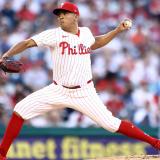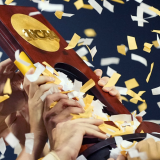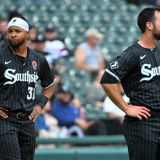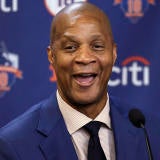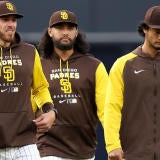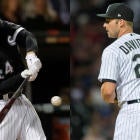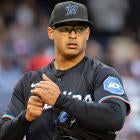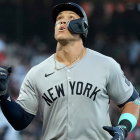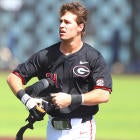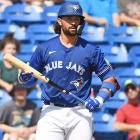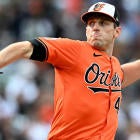The Tampa Bay Rays are reportedly considering a play for free agent Matt Davidson, a power-hitting corner infielder and designated hitter who also happens to have a wicked curveball.
If baseball's rare and unproductive history with two-way players is any indication, such an effort will likely prove futile. Yet the prospect of a player producing as a regular both on the mound and at the plate is so tantalizing, teams keep investigating ways to tap into that huge potential. It's led to a mini-boom in two-way players in today's game, as teams keep chasing that elusive dragon.
The easiest, lowest-pressure way to shoehorn players into both roles is to give position players cameos on the mound. Last season saw a record number of position players toe the rubber, with 48 of them tackling the task. Last summer, CBS Sports' Mike Axisa outlined the growing prevalence of this trend.
Monday night, the Cubs dropped a game to the Diamondbacks (ARI 7, CHC 1), and they used not one, but two position players to pitch. Backup catcher Victor Caratini recorded three outs (on five pitches!) and first baseman Anthony Rizzo got one out as well. A star player pitching? Teams usually don't take that risk.
The Caratini/Rizzo game comes three days after the Cubs used three -- three! -- position players (Caratini, Tommy La Stella, Ian Happ) in the final 3 1/3 innings of a blowout loss to the Cardinals. That happened 10 days after the D-Backs used Daniel Descalso and Alex Avila for 4 2/3 innings in a blowout loss at Coors Field.
Prior to the Descalso/Avila game, one team had not used two position players to pitch in a game since the Blue Jays used Ryan Goins and Darwin Barney on the mound in a 19-inning game in 2016. Baseball went almost exactly two years between games with two position players pitching for one team. Now it's happened three times in the last two weeks.
As entertaining as it can be to watch position players throw at Little League speeds and have a blast doing it, players like Rizzo getting their once-in-a-lifetime shot on a major-league pitching mound doesn't really fall under the umbrella of two-way players. Rather, it's almost always a way for teams to preserve their relief pitchers' arms, given how challenging the grind of six-plus months of firing pitches can be.
Davidson taking his place on the mound might have started as a similar lark, a way for a manager to give an eager player a chance to do something he might not otherwise get to do, with a blowout game providing a low-pressure environment in which to do it. But Davidson, who worked primarily as a pitcher until his junior year of high school, turned out to be something other than your typical sacrificial lamb. Instead of throwing meatballs and flashing sheepish grins as his pitches got crushed for tape-measure home runs, he did stuff like this:
2018 PitchingNinja Award for Position Player Pitcher of the Year. 🏆
— Rob Friedman (@PitchingNinja) December 14, 2018
Matt Davidson pic.twitter.com/Moj67B2NFP
Davidson went on to toss three innings of relief in 2018, allowing just one hit and one walk, striking out two, and allowing not a single run. That made him just the fourth position player since the advent of the DH in 1973 to start his pitching career with three or more scoreless innings. More than just amusing those of us who love a good sideshow (and winning the coveted Cy Dunn award), Davidson flashed a 92-mph fastball and much better feel for pitching than you'd expect to see from a typical position player having a laugh.
Late last season, he asked the White Sox for permission to work on his pitching in the offseason, in the hopes of becoming a two-way player who could throw some innings of relief to take pressure off Chicago's bullpen. The Sox granted that permission but likely won't get to reap any potential rewards, as they opted not to tender him a contract for 2019. Chicago's loss could thus become Tampa Bay's gain.
If the Rays do scoop up Davidson and his 46 homers and three scoreless frames over the past two seasons, they could officially declare a trend. With the fourth overall pick in the 2017 draft, Tampa Bay picked Brendan McKay, a dynamic high-school athlete who fared so well as both a first baseman and a swing-and-miss left-handed pitcher that the Rays decided to develop him as a true two-way prospect. Rated the Rays' number-two prospect by MLB.com, McKay batted .214/.368/.359 across three levels of minor-league ball last year, showing a patient approach at the plate but also a need to refine his swing. His pitching, on the other hand, was first-rate, as McKay punched out 103 batters in 78 1/3 innings, while allowing just 55 hits, 14 walks, and three home runs.
Potentially carrying a pair of two-way players in their organization would make the Rays relative unicorns, given how unusual it is to see legitimate two-way threats. Though they wouldn't quite be alone.
Last season, the Rangers claimed two such players. Brett Eibner is a former outfielder who tried to transition to pitching while in the Dodgers organization, before hurting his elbow and undergoing Tommy John surgery. He fared well on the mound in limited action last year, though, flashing a 1.80 ERA in 15 innings of minor-league work. Eibner joined Anthony Gose, a speedy, strong-armed outfielder who also added pitching to his repertoire in the hopes of making it in the Show as a two-way player. (That doesn't include Matt Bush, the Padres' former No. 1 overall pick who flamed out as a shortstop prospect, only to transition to pitching and log some effective innings with Texas years later.)
Other players of recent vintage who've attempted to play both ways include former Padres catcher turned catcher-and-pitcher Christian Bethancourt, Red Sox pitching prospect turned hopeful pitcher-outfielder Trey Ball, and going back a few years, outfielder/reliever Brooks Kieschnick.
If the mention of Brett Eibner and Christian Bethancourt and Brooks Kieschnick doesn't inspire visions of Cooperstown ceremonies, that's because the thin ranks of two-way players have mostly consisted of limited talents who sought another skill in the hopes of landing more secure employment.
That's what made Shohei Ohtani so heart-stoppingly exciting when he arrived on this side of the ocean. We'd all heard stories of Ohtani bamboozling opposing hitters with his wicked stuff as a pitcher, while launching mammoth home runs as a hitter. But we couldn't help but wonder if those skills would hold up in the majors. Not so much because we doubted his talent, but because so few people alive today had ever witnessed a player who could truly excel both at the plate and on the mound. If we'd grown that excited over Rick Ankiel kicking his Steve Blass Disease and returning as an outfielder with huge holes in his swing (but an occasional ability to loudly connect), imagine the pandemonium that could ensue if a fresh-faced, two-way Japanese rookie could take the league by storm from day one.
The book on Ohtani was that he had two potential weaknesses that could slow his ascent toward two-way stardom. The first was that he might struggle against major-league breaking balls. Then, in his first at-bat at Angel Stadium, Ohtani tracked a curveball that dropped right into the zone. And this happened.
It was the second potential weakness that came back to haunt Ohtani. The fear with many Japanese pitchers is that overuse at a young age could lead to injuries later on, especially as those pitchers adjust to the grind of a long MLB season. Sure enough, Ohtani lasted just 10 starts in his rookie campaign, got hurt, and finally went under the knife for Tommy John surgery at season's end. We'll see more of Ohtani's impressive home-run swing in 2019, but we won't see him stare down a catcher's signs until some time next year.
So for now, we keep on hoping. We hope that Ohtani can come back fully healthy and regain the promise of becoming the best two-way player since Babe Ruth dazzled the league with both his arm and his bat. And yes, we'll root for guys like Matt Davidson, and hope they can do enough in both roles just to hold their own. Given how damn tough and rare that can be, we'll take two-way competence, while secretly pining for two-way stardom.







